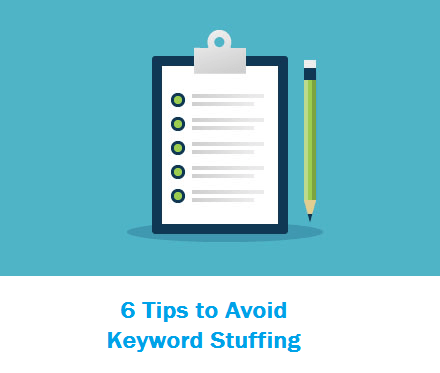6 SEO Techniques How to Avoid Keyword Stuffing
Gone are the days when you could merely optimise your page for a particular keyword, and you were guaranteed to rank high on search engine pages. These outdated SEO tactics grew into prominence when they proved useful in the short-term. Nowadays, having the keywords in your content is not enough, especially if you stuffing them everywhere. SEO copywriters that practice keyword stuffing techniques are in for a rude awakening.
Search Engines like Google have employed algorithms to crawl websites that stuff keywords in hopes that they can be the authority for the query. We’ve collated ways that you can tell whether your page has been over-optimised for a related keyword. Our guide will improve your overall writing and also introduce tools that will help you avoid being penalised by search engines for keyword stuffing.

What is keyword stuffing?
To understand what keyword stuffing is, we first have to define the term keyword. Loosely put, a keyword is a term that an article or webpage focuses on. Writers create content around the keyword to help internet users find related web pages centred around the keyword. Keyword stuffing, in this instance, relates to the overuse of the keyword intended to meet search engine requirements in order to help the webpage rank high for a keyword.
You’ve probably come across articles that have stuffed keywords before, but you just didn’t know what it was. It disguises itself as poorly written content because the keywords are all over the place. You’ll sometimes find grammatically incorrect keyword association that does not make sense, but it’s all intended to satisfy the search engine’s criteria. While it may seem like these techniques are counterintuitive, they have proved to get the desired outcome. We’ve listed some of the dark arts of SEO techniques known as Black Hat techniques.
Black Hat SEO VS White Hat SEO Techniques
Black Hat techniques represent a host of SEO tactics that pay little attention to the overall user experience of a webpage and focus on rankings. These SEO strategies start from the conceptualisation of the page, placement and link building; it disregards search engine guidelines in order to rank well. Keyword stuffing is one such move, along with the following:
- Reporting negatively on competitors
- Content Automation
- Google Hidden Text
- Several Doorway Pages
- Dubious Redirects
- Keyword Cloaking
- Duplicated Content
- Spam Stuffing
The opposite of all these underhanded techniques is what is called White Hat SEO techniques. These SEO strategies remain the crème de la crème of SEO writing, with the content keeping in line with search engine requirements. White Hat techniques are all the prescribed SEO practices that meet the overall user’s needs as well as have high SEO value. The best forms of white hat-related methods are represented by
- Well-researched and written content.
- Mobile-friendly and fast loading webpage.
- Clear navigation routes throughout the entire website.
- Content that answers the query.
- Descriptive keyword meta tags.
Useful Tools Help Prevent Keyword Stuffing
Part of writing content that answers a query is doing your due diligence and conducting thorough research. The following tools have come highly recommended by top SEO strategists that specialize in writing great content. There’re plenty of tools that help writers optimize their content to avoid keyword stuffing and ensure precise keyword optimisation.
- SEMrush – helps you find related keywords (https://www.semrush.com ).
- SEOPowersuite – gives you a score of how much you should use the keyword in your content. (https://www.seopowersuite.com ).
- Ryte – helps you understand which keywords your competitors are using and how they are using them. (https://en.ryte.com ).
- SEOLyse – helps you check your TF-IDF Score (https://www.seolyze.com/en ).
- Yoast – The WordPress plugin flags under and overuse of the keyword (https://yoast.com).
- Alchemy – this tool helps you narrow down the overall concepts of an article (https://natural-language-understanding-demo.ng.bluemix.net/ ).
The aforementioned keyword tools all look at the Keyword Density of the page as well as its overall relevance to the page.
Consequences of Too Many Keywords SEO – Types of Google Penalties
Search Engines have implemented tactics to ban SEO practices that fall out of bounce from their rules. This is very important because what search engine result pages (SERPs) use to rank a page always changes from time to time. Search Engines are no longer lenient to sites that practice Black Hat techniques. Failure to comply with their guidelines results in the following penalties:
- Lose content authority – your site will not be regarded as the authority on a certain subject, and that will be evident in the search traffic to the page.
- No indexing – The website will be demoted and if these techniques persist, lead to no indexing. Check for indexing typing the following site:domain.com to see if your page exists.
6 Tips to Avoid Keyword Stuffing
With search engine penalties affecting the bottom line of what the intended objective of a website is, we’ve examined six ways you can manually prevent being penalised. These SEO practices are in line with what search engine prescribes as good SEO techniques and by extension can be regarded as white hat techniques.
- Keyword Research: we recommend using Google Webmaster Tools Keywords finder to hunt for related search results and keywords for a specific topic.
- Use the tools above to perform a thorough competitor analysis. These tools will indicate keywords with high search volumes, relevance and the appropriate keyword density.
- The quality of content you write must answer the search query without beating around the bush. This also includes avoiding black hat techniques to help boost traffic in the short term.
- Make sure your content is Grammar Proof because the audience will show their disapproval by clicking away from your site. Google also uses a high bounce rate to punish poorly written material.
- Stick to the TF-IDF recommended score. This range is used to inform SEOs of the average and accepted keyword density on a page.
- Use Long-Tail Variations of the keyword to avoid repetition of the same keywords.
Keyword Stuffing Conclusion
Avoiding keyword stuffing SEO practices is essential because the penalties are very worrisome. There is no clarity as to how Google crawls your webpage, and the algorithms used to rank the website. Thus, once you’ve created a good content and rank high for it, it is unlikely that you will lose authority for the search query. Put our tips into practice and watch your webpage and overall website improve.
If you are uncertain about the best course of action and the best tool to use, leave a comment and we’ll tackle it together. Alternatively, browse through our Keyword Stuffing presentation that clearly illustrates how to avoid search engine penalties due to keyword stuffing.



